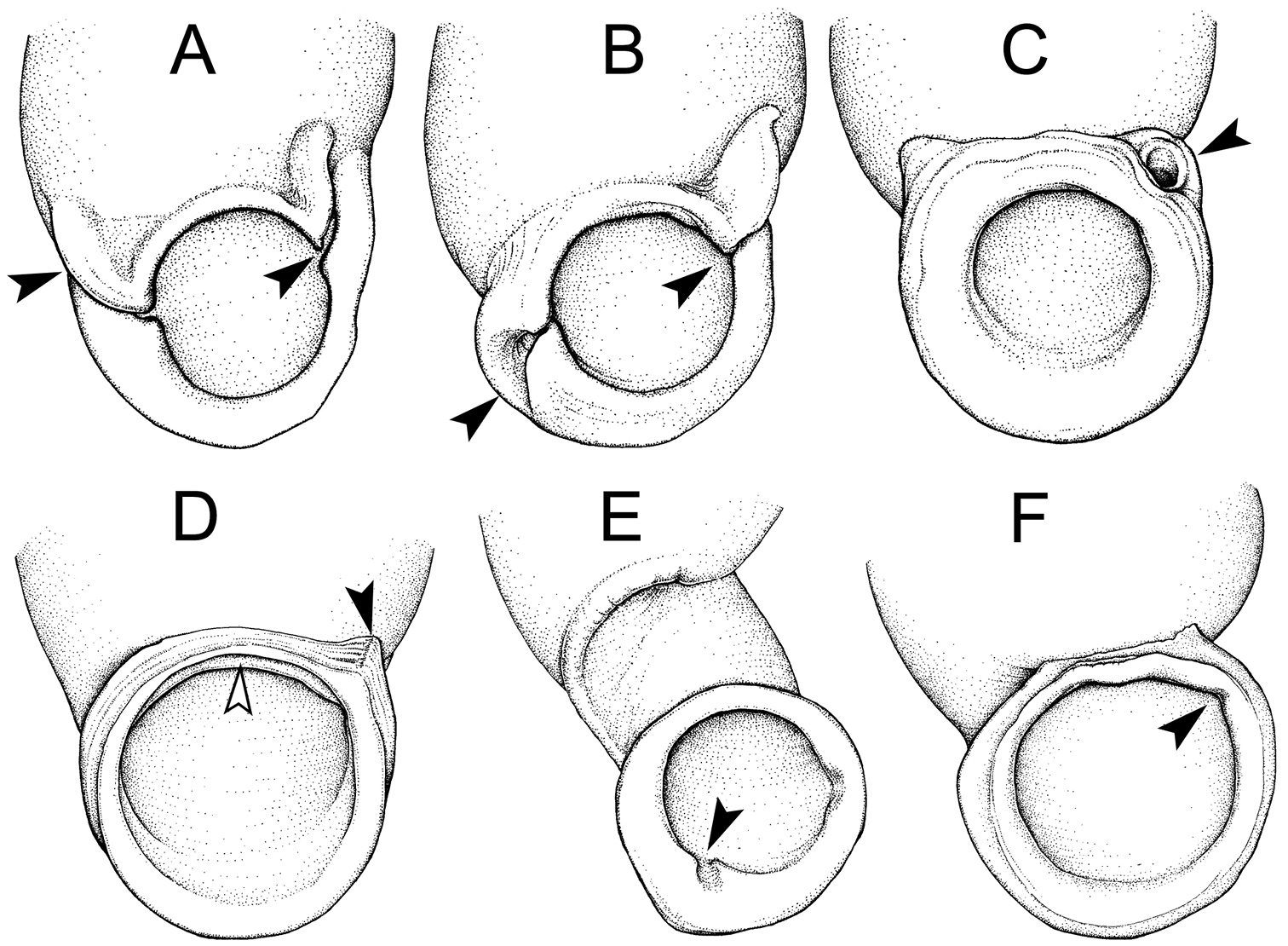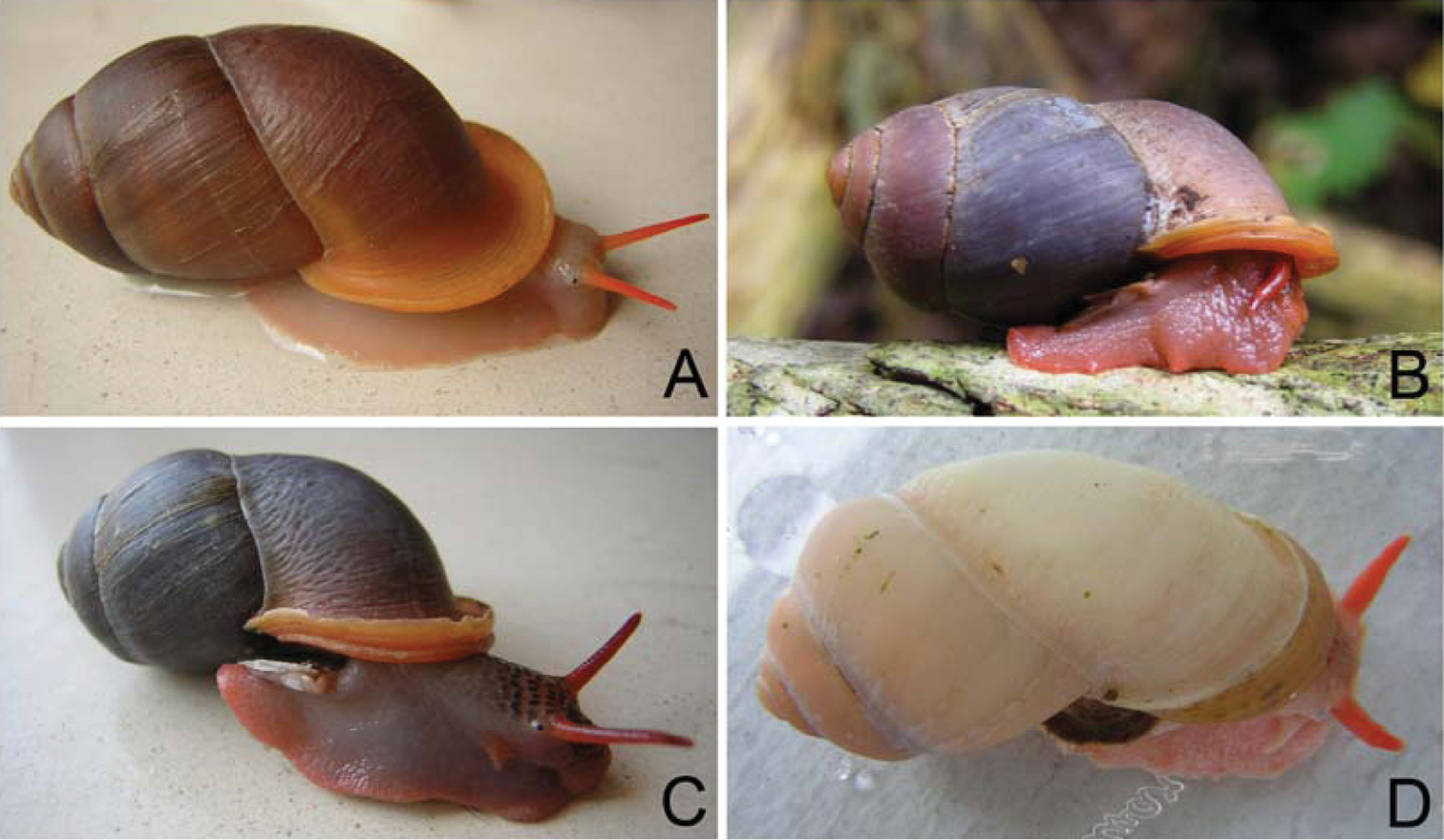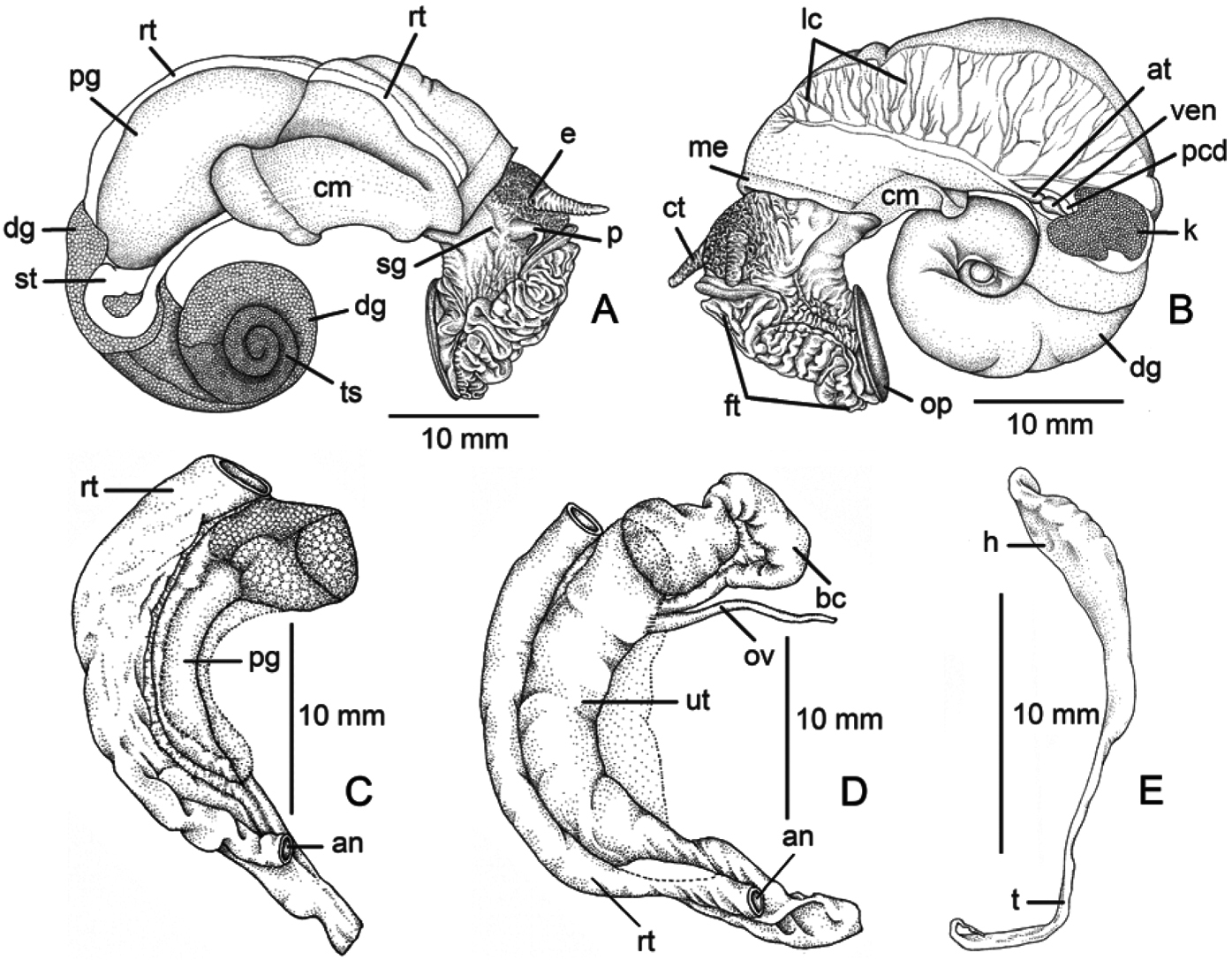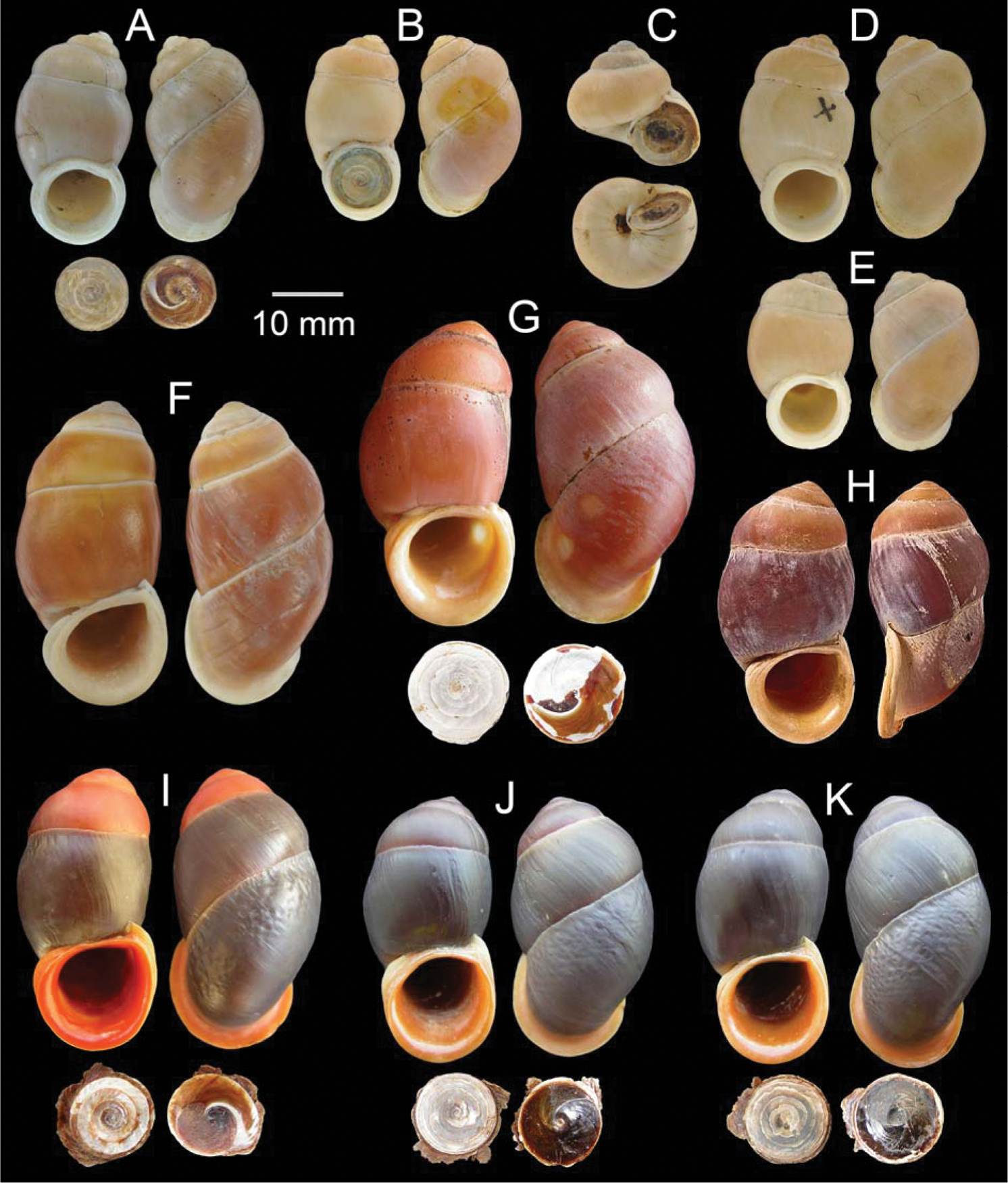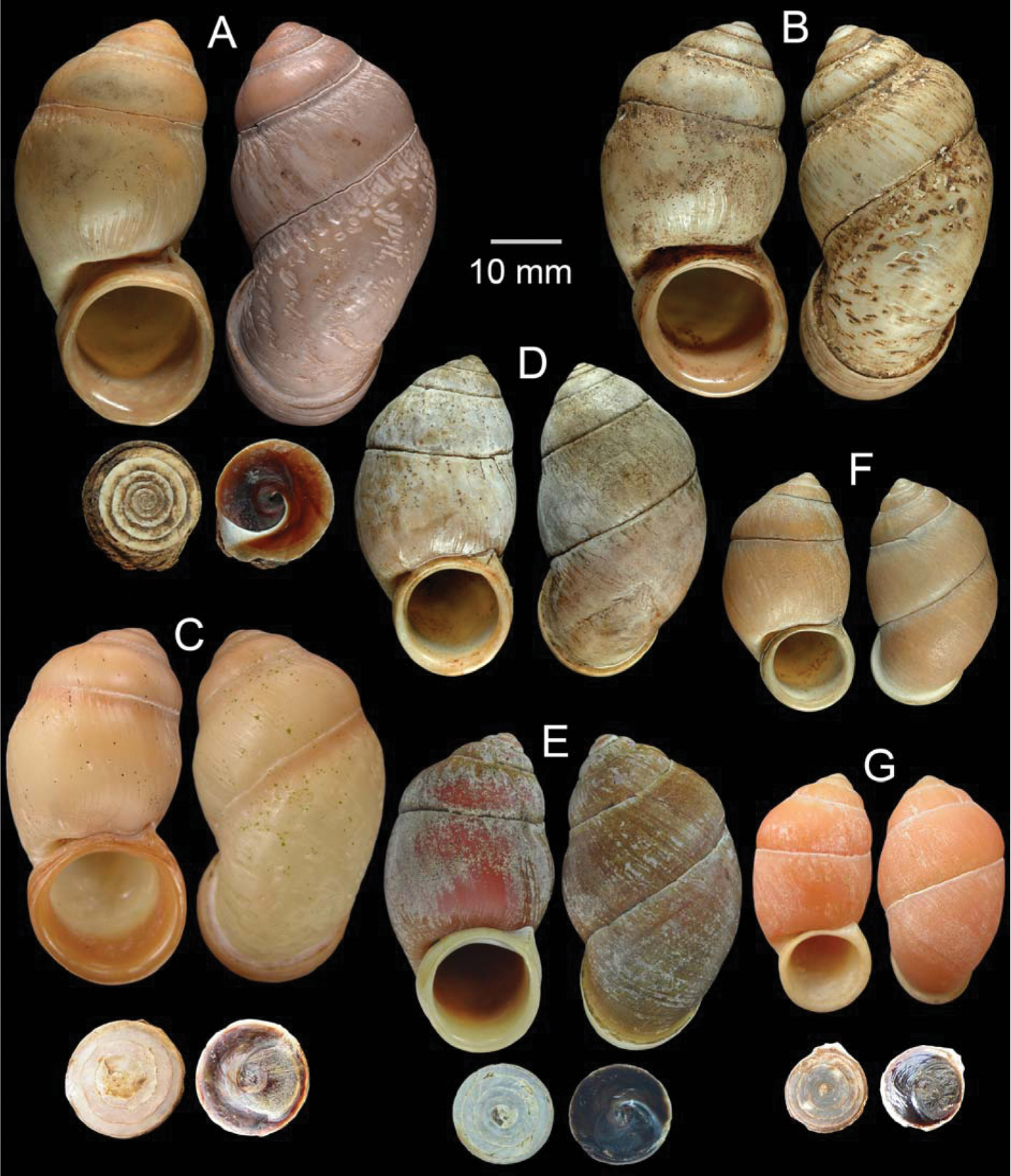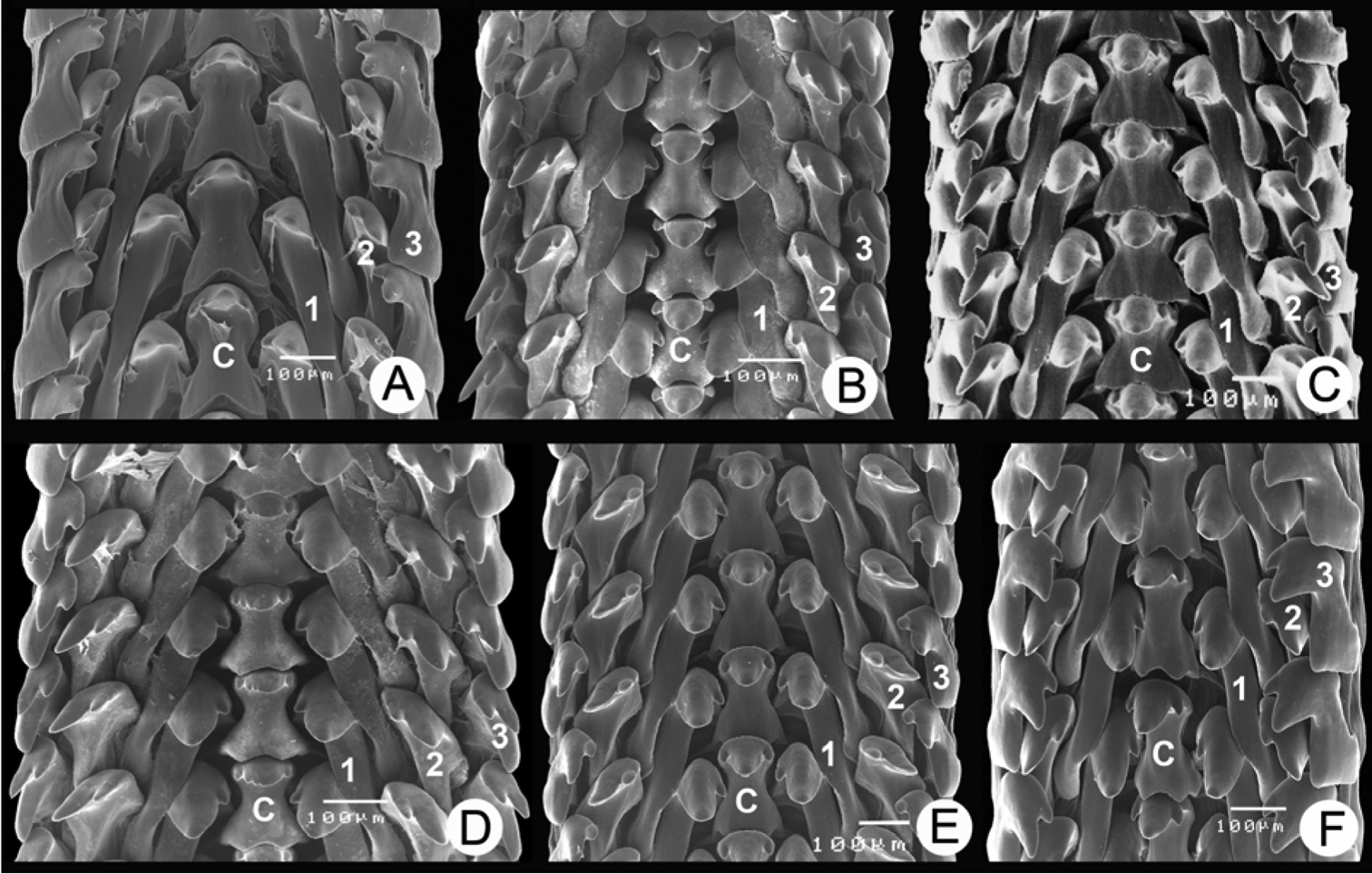






(C) 2013 Bangon Kongim. This is an open access article distributed under the terms of the Creative Commons Attribution License 3.0 (CC-BY), which permits unrestricted use, distribution, and reproduction in any medium, provided the original author and source are credited.
For reference, use of the paginated PDF or printed version of this article is recommended.
The status of species currently assigned to the Southeast Asian Elephant Pupinid snail genus Pollicaria Gould, 1856 is reassessed. Shell, radular and reproductive morphology are investigated and analysed with reference to karyotype patterns previously reported and to distribution patterns among the species. Six previously described species are recognised: Pollicaria gravida (Benson, 1856), Pollicaria myersii (Haines, 1855), Pollicaria mouhoti (Pfeiffer, 1862), Pollicaria elephas (Morgan, 1885), Pollicaria crossei (Dautzenberg & d’Hamonville, 1887) and Pollicaria rochebruni (Mabille, 1887). A new subspecies, Pollicaria mouhoti monochroma ssp. n., is proposed and a dichotomous key to species is provided.
Systematics, Indochina, Gastropoda, land snail, Southeast Asia, anatomy
Land operculate snails of the family Pupinidae generally possess a pupoid shell shape and exhibit a wide range of shell height from 5–50 mm. Apart from size, their often distinctive shells can also be distinguished from other members of the Cyclophoroidea by unique features of the genitalia, notably the long bursa copulatrix (
Hitherto, nine nominal species of the Pollicaria have been described (
The large shell size (up to 50 mm in height) and distinctive yellow to orange body colour render Pollicaria very distinctive and easily recognizable, although some confusion might arise from the helicoid shape exhibited by juveniles. The fact that populations are often widely scattered and highly localized may account for their having been little studied and consequently poorly known (
Herein, we provide the first critical and comprehensive revision of Pollicaria based on a detailed morphological study of newly collected specimens and their comparison with type material.
Snails were collected and distributions recorded, mostly from limestone areas throughout Thailand, Laos, Vietnam and Peninsular Malaysia. Species identifications were made by comparison with type material, primarily at The Natural History Museum (London), Muséum National ďHistoire Naturelle (Paris), and University Museum of Zoology Cambridge (Cambridge). Living snails were photographed before examining the external and internal morphological characters. Adult shells were measured for height, diameter and whorl number. Features of the genitalia were examined for between 5 to 10 individuals of each species. Radulae were extracted and examined using a Scanning Electron Microscope (JEOL, JSM-5410 LV), and radular teeth shape and formulae were described.
Anatomical abbreviation: The following anatomical terminology used in this study was modified from
Institutional abbreviation: NHMUK, The Natural History Museum, London; CUMZ, Chulalongkorn University, Museum of Zoology, Bangkok, Thailand; MNHN, Muséum National ďHistoire Naturelle, Paris; RBINS, Royal Belgian Institute of Natural Sciences, Brussels, Belgium; SMF, Forschungsinstitut und Naturmuseum Senckenberg, Frankfurt, a.m.; UMZC, University Museum of Zoology Cambridge, Cambridge; ZMA, Zoologische Museum of Amsterdam, Amsterdam; ZMB, Zoologisches Museum of Berlin, Berlin; ZMMSU, Zoological Museum of Mahasarakham University, Thailand.
Shell characters: Pollicaria Gould, 1856 is distinguished from other closely related genera such as Pupina Vignard, 1829, Pupinella Gray, 1850 and Raphaulus Pfeiffer, 1856 by having greater shell size, a breathing device in the form of a shallow posterior angled groove, and with or without a parietal declining shoulder inside the peristome (Fig. 1D). Pupina and Pupinella have anterior (columellar) and posterior (sutural) canals, with the columellar canal slightly twisted in Pupinella (Fig. 1A, B); Raphaulus has a complete posterior tube (Fig. 1C). Pollicaria differs from Tortulosa Gray, 1847 (Fig. 1E) and Schistoloma Kobelt, 1902 (Fig. 1F) by having a pupoid shell shape, larger shell size that lacks either an anterior (peristomal) groove (Fig. 1E) or posterior groove (Fig. 1F) respectively.
Breathing devices of six genera within the Pupinidae; black arrow indicates the position of breathing devices. A Anterior and posterior canals of Pupina B Anterior canal and twisted posterior canal of Pupinella C Complete posterior tube in Raphaulus D Shallow posterior angled groove of Pollicaria, white arrow indicates the parietal declining shoulder inside peristome E Anterior (peristomal) groove inside aperture of Tortulosa F Thin posterior groove inside aperture of Schistoloma.
External features: As recorded in the literature, Pollicaria was found to possess a yellow-orange to pale orange body, usually with dark orange cephalic tentacles (Fig. 2). Body colour variation within species appeared to be largely confined to patches of dark-brown or blackish spots spread across areas of the head and dorsal foot. Such variation may be present between different populations or can occur on different growth stages within populations.
Living snails. A Pollicaria myersii from Pahom, Vang Vieng, Laos (CUMZ 1572; shell height about 40 mm) B Pollicaria mouhoti mouhoti from Tam Wungdang, Phitsanulok (CUMZ 1533; shell height about 35 mm) C Pollicaria mouhoti monochroma ssp. n. from the type locality (paratype CUMZ 1548; shell height about 30 mm) D Pollicaria elephas from Ipoh, Perak, Malaysia (CUMZ 1536; shell height about 45 mm).
The foot (ft) is broad and short; cephalic tentacles (ct) long with dark eye spots (e) located at outer base; snout broad. Animal dioecious; genital groove present at right side running downwards from pallial gonoduct. Male with conical external penis (p) on the right side (penis usually broad and enlarged in breeding season) located below cephalic tentacles, and with seminal groove (sg) on penis (Fig. 3A); female with only genital groove on the right side disappear external penis. Operculum (op) attached to opercular lobe or disk posterior-dorsally on foot (Fig. 3B).
General anatomy, genitalia and spermatophore of Pollicaria mouhoti mouhoti. A Right side of snail showing male genital organ B Left side of snail showing pallial cavity and circulatory system C Male genital organ D Female genital organ E Spermatophore from uterus.
No external anatomical features were found to exhibit useful taxonomic characters.
Internal anatomy: The internal anatomical description of Pollicaria mouhoti mouhoti collected form Tam Wungdang, Nern Maprang, Phitsanulok, Thailand serves as being representative of the genus. Kidney (k) a brownish lobule, constricted-triangular in shape. Heart located on the left side of kidney; pericardium (pcd) thin, atrium (at) slightly larger than ventricle (ven). Lung cavity (lc) with reticulated vessels. Stomach (st) embedded in dark brown lobulated digestive gland (dg). Rectum (rt) large, attached to genital apparatus (prostate gland or uterus), and tapering anteriorly to anus (an), which opens close to mantle collar edge. Mantle edge (me) smooth and slightly thickened. Columellar muscle (cm) large, broad, thickened and whitish (Fig. 3A–D).
Testis (ts) with branched tubules, bright orange, occupying around 2-3 whorls from apex. Vas deferens thin and slender-straight tube attached to prostate gland at around two-third of its length proximal to external penis. Prostate gland (pg) large, long and slender, pale yellowish; proximally with genital opening. Seminal groove (sg) small, distinct and connected from genital opening on the right side of snail to external penis. External penis (pen) digitiform, short, located posteriorly, below cephalic tentacles (Fig. 3A, C).
Ovary bright orange multi-lobulated gland embedded in digestive gland. Pale yellow oviduct (ov) extends from ovary to uterus (ut) near the base of seminal receptacle. Bursa copulatrix (bc) cream to whitish long pouch that receives and digests the spermatophore case. Uterus (ut) large, curved pea-pod shape, posterior end rounded and anterior end tapering with genital opening (Fig. 3D).
Spermatophore tadpole shaped, about 20 mm long. Anterior portion or head of spermatophore (h) is a swollen pouch with thickened wall that is packed with sperm. Posterior portion or tail (t) tapering to slender tube is about half of the total length (Fig. 3E).
Both male and female genital organs of all species except Pollicaria gravida were examined and no distinguishing species-level taxonomic characters were found.
http://species-id.net/wiki/Pollicaria
Cyclostoma pollex Gould, 1856: 14; by monotypy (see
When describing his new species as Cyclostoma pollex,
Shell pupoid, small to large (shell height 35–50 mm), thickened and solid. Shell smooth or malleated sculpture from almost white to pale yellow, reddish brown and nearly black; periostracum generally thick. Whorls 5–7, last whorl expanded, body whorl distorted when adult; sutures weakly impressed. Aperture rounded, shallow to absent posterior angled groove; peristome continuous and thickened; lip duplicated and reflexed; umbilicus narrow. Operculum multi-lamellar calcareous plate. Radula taenioglossate with seven teeth in each transverse row.
| 1 | Peristome with declining shoulder inside peristome (Fig. 1A) | 2 |
| – | Peristome without declining shoulder inside peristome (Fig. 1B) | 4 |
| 2 | Shell small (height < 35 mm) | 3 |
| – | Shell large (height > 40 mm), shell ground colour brown to black, periostracum corneous | Pollicaria rochebruni |
| 3 | Shell pale yellow | Pollicaria gravida |
| – | Shell bright orange | Pollicaria crossei |
| 4 | Shell usually large (height > 40 mm) | 5 |
| – | Shell small (height < 35 mm) to medium (35 < height < 40 mm), with bright orange, purple to black | 6 |
| 5 | Shell dark orange to pale orange, lip duplicated, dorsal part of last whorl pitted | Pollicaria elephas |
| – | Shell elongate pupoid, brown to red, periostracum thick corneous, lip expanded, dorsal part of last whorl malleated | Pollicaria myersii |
| 6 | Spire and apex bright yellow to orange, shell medium (35 < height < 40 mm) | Pollicaria mouhoti mouhoti |
| – | Spire monochrome purple to black, shell small (height < 35 mm) | Pollicaria mouhoti monochroma ssp. n. |
http://species-id.net/wiki/Pollicaria_gravida
Fig. 4A–E; Tables 1, 2Five shells in the type series of W.H. Benson, the specimen with similar shape, size and colour to the original description is designated here as the lectotype of Megalomastoma gravidum Benson, 1856 UMZC I.102935.A (height 32 mm, width 18 mm; Fig. 4A) and paralectotypes UMZC I.102935.B-E (4 shells, Fig. 4B); syntype of Otopoma blennus Benson, 1856 UMZC I.102930.A-B (2 shells, Fig. 4C).
Burma: NHMUK 79.9.1.5-6 (2 shells), Theobald colln. Acc. no. 1592 (2 shells), B.R. Lucus colln. Acc. no. 2351 (2 shells), Trechmann colln. Acc. no. 2176 (2 shells), 2 lots of E.R. Sykes collns. Acc. no. 1825 (1 shell and 2 shells); ZMA: R.v. Lennep colln. Acc. no. 1876 (1 shell); ZMB: Paetel colln. (1 shell), 2 lots of Dunker collns. (1 shell, 2 shells), Nevill colln. ZMB 20723 (2 shells). Farm Cave, Moulmein: NHMUK 88.124.863.4-5 (3 shells, Fig. 4D, E). Moulmein, Burma: NHMUK 71.9.23.193 (1 shell), 24.06.4.4 (2 shells), 1954.6.2.1231-1 (2 shells), H. Cuming colln. (4 shells), 2 lots of H.F./W.T. Blanford collns. Acc. no. 1944 (5 shells, 2 shells), T. Oldham colln. Acc. no. 1733 (2 shells); ZMA: Schepman colln. (1 shell). Unknown locality: NHMUK V.W. MacAndrew coll. (4 shells), H.E.J. Biggs colln. Acc. no. 2258 (2 shells), H. Cuming colln. (1 shell).
Shell morphology of Pollicaria spp. A–E Pollicaria gravida A lectotype UMZC I.102935.A B paralectotype UMZC I.102935.B-E C syntype of Otopoma blennus Benson, 1856 UMZC I.102930.A and D, E specimens from Farm Caves, Moulmein, Burma (NHMUK 88.124.863.4–5; specimen with ‘x’ was figured in
Comparative morphological characters and karyotype among Pollicaria species recognized in this study.
| Characters | Pollicaria gravida | Pollicaria myersii | Pollicaria mouhoti | Pollicaria elephas | Pollicaria rochebruni | Pollicaria crossei |
|---|---|---|---|---|---|---|
| Shell size (shell height) | small (height <35 mm) | large (height > 40 mm) | small to medium | large (height > 40 mm) | medium (35 < height > 40 mm) | small (height <35 mm) |
| Umbilicus | perforate | narrow | subumbilicate | narrow | narrow | narrow |
| Periostracum; shell colour | transparent; whitish to yellow | transparent; monochrome pale orange | transparent; monochrome black or with orange apex | transparent; yellow to orange | thicken corneous; reddish to orange | transparent; pale to deep orange |
| Sculpture on last whorl | absent | with thin wrinkle sculpture | with prominent wrinkle sculpture | with prominent wrinkle sculpture | absent | absent |
| Peristome shape; colour | rounded; as hell colour | slightly distorted; orange | slightly distorted; bright orange to reddish | rounded; as shell colour | rounded; as shell colour | rounded; as shell colour |
| Apertural groove | present | absent | absent | absent | present | present |
| Karyotype* | not available | 4m+6sm+2st+ 1t | 6m+4sm+2st+ 1t 7m+3sm+2st+ 1t | 2m+6sm+2st+ 3t | 3m+7sm+2st+ 1t | 2m+8sm+2st+ 1t |
* Data from
Shell size variation among Pollicaria species recognized in this study.
| Species, Locality and CUMZ nos. | Number of adult shell examined | Ranges, Mean ± SD in mm of: | Whorl ranges | ||
|---|---|---|---|---|---|
| Shell Height | Shell Width | h/d Ratio | |||
| Pollicaria gravida | |||||
| UMZC and NHMUK collections | 14 | 24.7–34.3 29.8 ± 2.54 | 14.6–19.0 17.4 ± 1.58 | 1.65–1.82 1.71 ± 0.12 | 5¾-6¼ |
| Pollicaria myersii | |||||
| Pahom, Vang Vieng, Laos: 1520, 1572 | 10 | 37.8–50.6 43.4 ± 3.94 | 18.6–23.9 21.1 ± 1.68 | 1.97–2.16 2.06 ± 0.05 | 6¾-7 |
| Pollicaria mouhoti mouhoti | |||||
| Namnao N. P., Phetchabun: 1538, 1574 | 7 | 36.2–41.5 37.6 ± 1.74 | 18.4–21.6 19.6 ± 0.96 | 1.85–1.99 1.92 ± 0.05 | 6½ |
| Phu Kiew Wildlife Sanctuary, Chaiyaphum: 1551, 1528, 1529, 1571 | 65 | 33.6–44.1 37.7 ± 2.26 | 17.8–23.3 19.5 ± 1.20 | 1.86–2.14 1.94 ± 0.06 | 6–6¾ |
| Tam Wungdang, Phitsanulok: 1533, 1537 | 40 | 33.4–40.8 36.7 ± 1.81 | 17.6–21.2 19.0 ± 0.83 | 1.86–2.05 1.93 ± 0.05 | 6–6½ |
| Wat Pa-Mamuang, Phitsanulok: 1541 | 13 | 33.9–40.4 37.7 ± 2.12 | 18.4–20.2 19.6 ±0.78 | 1.82–2.04 1.92 ± 0.06 | 6–6½ |
| Pollicaria mouhoti monochroma ssp. n. | |||||
| Phu Phalom, Loei: 1547 | 23 | 31.1–42.6 38.2 ± 2.52 | 17.9–21.4 19.4 ± 0.97 | 1.55–2.15 1.98 ± 0.11 | 6–6½ |
| Tam Pha Bing, Loei: 1561, 1562 | 134 | 30.5–39.1 34.5 ± 2.09 | 16.4–20.6 18.4 ± 1.03 | 1.78–2.13 1.88 ± 0.05 | 5¾-6½ |
| Tam Pha Singh, Loei: 1543 | 33 | 29.6–37.9 33.8 ± 2.41 | 15.8–19.5 17.6 ± 1.03 | 1.71–2.00 1.92 ± 0.06 | 5¾-6¼ |
| Wat Tam Pha Poo, Loei: 1545 | 56 | 30.2–36.7 32.5 ± 1.37 | 16.1–19.3 17.2 ± 0.64 | 1.76–2.00 1.89 ± 0.05 | 5¾-6 |
| Pollicaria elephas | |||||
| Ampang Baru, Ipoh, Perak, Malaysia: 1535 | 51 | 36.4–51.1 43.9 ± 3.12 | 19.4–24.5 21.9 ± 1.31 | 1.85–2.12 2.01 ± 0.06 | 6–6¾ |
| Gunung Kenting, Ipoh, Perak, Malaysia: 1534, 1536, 1596 | 182 | 36.4–49.9, 42.3 ± 2.34 | 11.1–25.6 21.9 ± 1.64 | 1.78–3.79 1.4 ± 0.15 | 6–6¾ |
| Pollicaria rochebruni | |||||
| Cuc Phuong N. P., Vietnam: 1521, 1532 | 8 | 32.6–42.3 40.1 ± 2.26 | 18.1–22.9 20.6 ± 1.66 | 1.80–2.09 1.95 ± 0.11 | 6¼ |
| Phuong Nga N. P., Vietnam: 1523, 1539, 1552 | 5 | 37.8–45.0 40.8 ± 2.74 | 20.0–21.8 20.7 ± 0.71 | 1.89–2.07 1.97 ± 0.07 | 6¼-6¾ |
| Pollicaria crossei | |||||
| Cuc Phuong N. P., Vietnam: 1521, 1522, 1588 | 10 | 32.6–38.0 35.3 ± 1.74 | 17.6–18.9 18.9 ± 1.01 | 1.82–1.93 1.87 ± 0.06 | 6¼ |
| Hulien, Vietnam: 1590 | 5 | 32.7–36.2 34.9 ± 1.43 | 18.0–19.8 18.7 ± 0.07 | 1.82–1.93 1.87 ± 0.05 | 6¼ |
Shell. Shell small for Pollicaria, pupoid, pale orange, yellow to white. Periostracum thin and transparent; shell surface smooth. Whorls 5–6; sutures moderately impressed; apex slightly inclined to right; spire short. Last whorl large about two-thirds of shell height, distorted and flattened in front. Aperture rounded with a shallow posterior angled groove. Peristome continuous, with distinct parietal declining shoulder internally. Lip thickened, little expanded, and margin moderately duplicated; umbilicus narrow. Operculum thick, calcareous, multispiral.
Accepted records are confined to Burma: Moulmein, Damontha, Tavoy and Tenasserim (
Otopoma blennus Benson, 1856 and Cyclostoma pollex Gould, 1856 have long been considered as junior synonyms of Pollicaria gravida and this classification has been followed by a number of authors (
Shell morphology of Pollicaria spp. A–C Pollicaria elephas A lectotype of Pollicaria elephas (MNHN 21309) B lectotype of Hybocystis jousseaumei Morgan, 1885 (MNHN 21308), and C specimen from Gunung Kenting, Ipoh, Perak, Malaysia (CUMZ 1536) D, E Pollicaria rochebruni D lectotype (MNHN 21305), and E specimen from Phuong Nga National Park, Vietnam (CUMZ 1568) F, G Pollicaria crossei, F lectotype (MNHN 21304), and G specimen from Cuc Phuong National Park, Vietnam (CUMZ 1588).
http://species-id.net/wiki/Pollicaria_myersii
Figs 2A; 4F, G; 6A; Tables 1, 2Siam: NHMUK 20090242 (Fig. 4F). Pahom, Vang Vieng, Laos: CUMZ 1531, 1572 (Fig. 4G), 1591; ZMMSU 0009.
Shell: Shell large, reddish brown to light orange. Periostracum thin, corneous; shell surface usually with fine malleations on upper half of last whorl. Aperture almost circular with a shallow posterior angled groove. Peristome yellow, parietal declining shoulder absent. Lip thickened, broadly expanded, reflexed, with concentric margin.
Radula: Radular teeth arranged in v-shaped rows, each transverse row with 7 teeth (2-1-1-1-2). Central tooth with well developed central cusp and one smaller lateral cusp on each side; central cusp large, elongate with pointed tip. Lateral teeth with 2 cusps, outer cusp largest and elongate shape with pointed tip, and with relatively small pointed tip of inner lateral cusps. Inner and outer marginal teeth with 2 cusps; central cusp large, flanked by small inner lateral cusps.
The type locality of this species was given as the broad location of “Siam” (see
The syntype AMNH 43629 could not be traced (Siddal and Watson, personal communication). Due to the proximity of the geographic distributions and similarity in shell morphology of the two species, Pollicaria mouhoti have long been considered a junior synonym of Pollicaria myersii (see
Radular morphology of Pollicaria spp. A Pollicaria myersii from Pahom, Vang Vieng, Laos (CUMZ 1572) B Pollicaria mouhoti mouhoti from Tam Wungdang, Phitsanulok (CUMZ 1533) C Pollicaria mouhoti monochroma ssp. n. from the type locality (paratype CUMZ 1548) D Pollicaria elephas from Gunung Kenting, Ipoh, Perak, Malaysia (CUMZ 1536) E Pollicaria rochebruni from Phuong Nga National Park, Vietnam (CUMZ 1568) F Pollicaria crossei from Cuc Phuong National Park, Ninh Binh Province, Vietnam (CUMZ 1588). Numbers indicated order of lateral and marginal teeth. Central tooth indicated by ‘C’.
http://species-id.net/wiki/Pollicaria_mouhoti
Shell small to large, pupoid, solid; monochrome purple to black, sometimes with yellowish to bright orange spire. Periostracum thin; shell surface with distinct malleations on upper half of last whorl. Whorls 5-6; sutures moderately impressed; apex obtuse. Last whorl large about two-thirds of shell height, distorted and flattened in front. Aperture almost circular, shallow posterior angled groove present. Peristome and inside aperture orange to red; parietal declining shoulder absent. Lip thickened, expanded, reflexed, margin slightly duplicated; umbilicus narrow. Operculum calcareous concentric.
The type locality of Pollicaria mouhoti was given as Laos Mountain, Cambodia. However, subsequent records of this species were from Thailand, Laos and Cambodia (
http://species-id.net/wiki/Pollicaria_mouhoti_mouhoti
Figs 2B; 3A_E; 4H, I; 6B; Tables 1, 2Three syntype shells in H. Cuming collection, the figures and labels with type specimen are designated here as the lectotype of Hybocystis mouhoti Pfeiffer, 1862 NHMUK 20130071/1 (height 34.2 mm, width 18.1 mm; Fig. 4H) and paralectotype NHMUK 20130071/2-3 (2 shells). Cambodia: ZMA Wright colln. (2 shells), R.v. Lennep colln. (1 shell). Laos Mountain: ZMB Paetel colln. (1 shell). Phu Kradung, Loei: CUMZ 1586. Namnao National Park, Phetchabun: CUMZ 1574, 1538; ZMMSU 0002. Tam Yai Namnao, Phetchabun: CUMZ 1559. Phu Phaman, Khon Kaen: ZMMSU 0012. Phu Kiew Wildlife Sanctuary, Nongbuadang, Chaiyaphum: CUMZ 1528, 1529, 1551, 1571, 1576, 1582, 1585; ZMMSU 0003, 0020-4, 0027, 0029. Phu Phachit, Chaiyaphum: ZMMSU 0013. Tam Tao, Nernmaprang, Phitsanulok: CUMZ 1558. Tam Wungdang, Nernmaprang, Phitsanulok: CUMZ 1533 (Fig. 4I), 1537, 1544, 1554, 1575. Wat Pa Mamuang, Nernmaprang, Phitsanulok: CUMZ 1541; ZMMSU 0015. Wat Thepitakpunnaram, Pakchong, Nakhon Ratchasima: CUMZ 1583. Tam Pu Loop, Phuphaman, Khon Kaen: CUMZ 1526. Namprom Dam, Khon Kaen: CUMZ 1584.
Shell: This nominotypical subspecies is characterized by the large shell size (Table 2). Shell with last whorl and penultimate whorl purple to black; first to third whorls distinct yellow to bright orange. Lip expanded, red to orange.
Radula: Taenioglossate radula, teeth arrangement with central, lateral and marginal teeth shape similar to Pollicaria myersii. Differences include a central tooth with well developed central cusp and lateral cusp on each side; lateral teeth triangular in shape with a pointed tip; inner marginal teeth composed of 3 cusps; central cusp flanked with small inner and outer lateral cusps.
This subspecies occupies the southern limit of the species’ range in Cambodia and several localities in Loei, Phitsanulok, Chaiyaphum, Khon Kaen, Phetchabun Nakhon Ratchasima and Saraburi Provinces in Thailand.
The characters distinguishing this nominotypical subspecies from Pollicaria myersii are the smaller shell size and mainly purple coloured shell with whorls 2-3 pale to bright orange and bright orange to red lip (Tables 1, 2), and a distinct karyotype pattern (
http://species-id.net/wiki/Pollicaria_mouhoti_monochroma
Figs 2C, 4J, K; 6C; Tables 1, 2Holotype: CUMZ 1577 (Fig. 4J; height 34.5 mm, width 18.4 mm, 6½ whorls) from the type locality, paratypes CUMZ 1548 (Fig. 4K; 9 shells), 1561 (82 shells), 1562 (85 shells); NHMUK 20130073 (5 shells); MNHN IM-2012-2103; SMF341492 (5 shells).
Limestone outcrop with dry forest at Wat Tam Pha Bing, Wungsapoong District, Loei Province, Thailand (17°14'1.3"N, 101°44'3.5"E).
Phakeng-Phanang, Loei: ZMMSU 0025, 0026. Phu Luang Wildlife Sanctuary, Loei: CUMZ 1524. Phu Phalom, Muang, Loei: CUMZ 1547, 1560, 1565, 1567, 1580. Phu Phasamyod, Loei: ZMMSU 0011. Tam Erawan, Wungsapoong, Loei: CUMZ 1555, 1579. Tam Pha Bing, Wungsapoong, Loei: CUMZ 1548, 1561, 1562, 1577, ZMMSU 0001, 0004, 0006, 0017, 0028. Tam Pha Singh, Wungsapoong, Loei: CUMZ 1543, 1546. Wat Po Thi-sat, Nonghin, Loei: CUMZ 1557. Wat Tam Kuhawari, Nonghin, Loei: CUMZ 1540, 1549. Wat Tam Pha Mak-ho, Wungsapoong, Loei: CUMZ 1530, 1542. Wat Tam Pha Poo, Loei: CUMZ 1545, 1550. Wat Tam Piya, Loei: CUMZ 1527. Khao Wungpha, Nawung, Nongbua Lumphoo: CUMZ 1563, 1564. Nawung, Nongbua Lumphoo: CUMZ 1581. Tam Suwankuha, Nongbua Lumphoo: ZMMSU 0007.
From the Greek monos = one or single, and chroma = color of the skin; referring to the characteristic uniform dark brown to blackish spire color of the shell.
Shell: Shell relatively small, pupoid, monochrome purple to black. Periostracum thin and transparent. Whorls 5-6; sutures moderately impressed; apex obtuse; spire short. Last whorl large about two-thirds of shell height, flattened in front. Shell surface rough with malleations on upper half of last whorl. Aperture almost circular, shallow posterior angled groove present; peristome continuous, yellow to pale orange. Lip thickened, broadly expanded; umbilicus narrow. Operculum thick, calcareous, concentric, exterior little concave.
Radula: Taenioglossate radula, teeth arrangement with central, lateral and marginal teeth shape similar to the nominotypical subspecies.
Pollicaria mouhoti monochroma ssp. n. is restricted to the northern limit of the species’ distribution in Loei, Phetchabun, Chaiyaphum and Nongbua Lumphoo Provinces.
Pollicaria mouhoti monochroma ssp. n. can be distinguished from the nominotypical subspecies by having a much smaller, entirely black to purple shell (Tables 1, 2) and a distinct karyotype pattern (see
Shell character variations can be observed in the Phu Pha Lom, Loei Province population. These individuals exhibit a relatively larger shell than the typical populations (Table 2), however, the monochrome black shell and similar karyotype pattern indicate that they belong to this subspecies (
http://species-id.net/wiki/Pollicaria_elephas
Figs 2D; 5A–C; 6D; Tables 1, 2Five lots with 13 specimens of syntype deposited in MNHN, the specimen figured in the original publication is designated as the lectotype of Hybocystis elephas Morgan, 1885 MNHN 21309 (Fig. 5A), paralectotype MNHN 21310 (5 shells), 21311 (2 shells), 21312 (3 shells), 21313 (2 shells), RBINS 525391 (1 shell). Single syntype specimen is designated as the lectotype of Hybocystis jousseaumei Morgan, 1885 MNHN 21308 (Fig. 5B). Ipoh, Perak, Malaysia: ZMA E.A. Meene colln. Acc. no. 1982 (1 shell). Near bridge over river, road Ipoh to Tanjong Rambutan, Perak, Malaysia: ZMA J. Drijver colln. (5 shells). Perak, Malaysia: ZMB 75821 (2 shells), 38044 (1 shell), M. Schulz colln. 1216 (3 shells, smallest shell excluded). Bukit Chintamani, Selangor, Malaysia: CUMZ 1534. Gunung Kenting, Ampang Baru, Ipoh, Perak, Malaysia: CUMZ 1535, 1536 (Fig. 5C), 1566, 1570.
Shell: Shell large, elongate pupoid uniform yellow to orange. Periostracum thin, corneous; shell surface with fine growth lines and last whorl with distinctly strong pitting dorsally. Whorls 6-7 whorls; sutures impressed; apex obtuse. Last whorl large about two-third of shell height, flattened in front. Aperture rounded, with shallow to deep posterior angle groove. Peristome continuous, little elevated, yellow to orange, internal parietal declining shoulder absent. Lip thickened, duplicated, and with distinct growth ridges; umbilicus narrow. Operculum thick, calcareous, concentric.
Radula: Taenioglossate radula, teeth arrangement with central, lateral and marginal teeth shape similar to Pollicaria myersii. Minor differences are the well-developed central cusp with one to three small lateral cusps of the central tooth, and the slightly elongate and slender central cusp of the inner marginal teeth.
This species has a restricted distribution and is known only from limestone outcrops in Perak, Peninsular Malaysia (
The locally endemic Pollicaria elephas is confined to a few limestone outcrops in Peninsular Malaysia and shows several unique shell characters that separate it from its congeners. The major distinguishing characters of this species are the very large, monochrome yellowish to pale orange shell with the last whorl distorted ventrally and sculptured with scattered, deep pits dorsally; and rounded and thickened aperture. (Table 2, Fig. 5A–C).
http://species-id.net/wiki/Pollicaria_rochebruni
Figs 5D, E; 6E; Tables 1, 2Four specimens of the syntype deposited in MNHN, the figured specimen in original publication is designated here as the lectotype of Hybocystis rochebruni Mabille, 1887 MNHN 21305 (Fig. 5D) and other specimens as paralectotype MNHN 25855. Bac Ma National Park, Vietnam: CUMZ 1556. Hulien Nature reserve, Vietnam: CUMZ 1594. Khe Sen, Danang, Vietnam: CUMZ 1589. Phuong Nga National Park, Quang Binh, Vietnam: CUMZ 1523, 1539, 1552, 1568 (Fig. 5E). Cuc Phuong National Park, Ninh Binh, Vietnam: CUMZ 1532, 1568, 1573, 1587.
Shell: Shell medium-sized, pupoid, red-brown. Periostracum thick, corneous; shell surface smooth. Whorls 5-6; sutures moderately impressed; apex obtuse; spire short. Last whorl large about two-thirds of shell height, distorted and flattened in front, ventrally rounded. Aperture rounded, shallow to absent posterior angled groove present. Peristome continuous, with thin parietal declining shoulder internally. Lip thickened, little expanded, margin moderately duplicated with thin growth ridges; umbilicus narrow. Operculum concentric, thick, calcareous, multi-spiral plate.
Radula: Taenioglossate radula, teeth arrangement with marginal teeth shape similar to Pollicaria myersii. Major differences are in the central teeth which have multiple cusps: the central cusp relatively short and small, flanked by 1-3 tapered lateral cusps; and inner marginal teeth with 3 cusps: the central cusp large with a convex tip, flanked by small and pointed inner cusps, the outer lateral cusp very small to nearly wanting.
The previous records of this species were from Tonkin (
Based on the similarity in shell morphology,
http://species-id.net/wiki/Pollicaria_crossei
Figs 5F, G; 6F; Tables 1, 2Single specimens of the syntype deposited in MNHN, the figured specimen in original publication is designated here as the lectotype of Hybocystis crossei Dautzenberg and ďHamonville, 1887 MNHN 21304 (Fig. 5F), and paralectotype RBINS 525390 (3 shells; the biggest one excluded). Cuc Phuong National Park, Ninh Binh, Vietnam: CUMZ 1521, 1522, 1588 (Fig. 5G), 1593. Hulien Nature reserve, Vietnam: CUMZ 1590.
Shell: Shell small, pupoid, bright orange. Periostracum thin, corneous; shell surface smooth. Whorls 5-6; sutures moderately impressed; apex obtuse; spire short. Last whorl large about two-thirds of shell height, distorted and flattened in front, ventrally rounded. Aperture rounded, with shallow to absent posterior angled groove. Peristome continuous, with thin parietal declining shoulder internally. Lip thickened, little expanded and duplicated; umbilicus narrow. Operculum thick, calcareous, concentric.
Radula: Taenioglossate radula, teeth arrangement with central, lateral and marginal teeth similar in shape to Pollicaria myersii.
The previous records of Pollicaria crossei was from Than-Moi, Tonkin and Cuc Phuong National Park, Ninh Binh, Vietnam (
Pollicaria crossei has long been recognized as a subjective synonym of either Pollicaria rochebruni or Pollicaria gravida (
We are grateful to M. Siddal and S. Watson (AMNH, New York); P. Bouchet, V. Héros and P. Maestrati (MNHN, Paris); J. Ablett and H. Taylor (NHM, London); T. Backeljau (RBINS, Brussel); R. Janssen (SMF, Frankfurt); R.C. Preece (UMCZ, Cambridge); R.G. Moolenbeek (ZMA, Amsterdam); M. Glaubrecht, F. Köhler and T. von Rintelen (ZMB, Berlin) for their assistance and kind permission to examine specimens and the type materials used in this study. We are also indebted to S. Tumpeesuwan and members of Animal Systematics Research Unit for their field assistance and also thank anonymous reviewers for providing helpful suggestions. This project was funded by an award from the Darwin Initiative Project (no. 14-653). Additional funding was provided by the MRG 5080405 to BK, the TRF Senior Research Scholar Grant from the Thailand Research Fund (TRF) 2012-2015 (RTA5580001) to SP. Other supports are from The National Research Council of Thailand and The National Research University Project (NRU) FW0646A-56.
